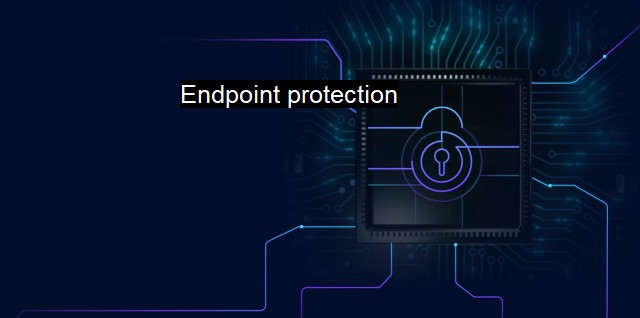What is Endpoint protection?
Securing Entry Points: Understanding Endpoint Protection Technologies for Modern Cybersecurity Threats
Endpoint protection is a comprehensive security approach that focuses on the endpoints of a network. This advanced methodology primarily seeks to secure every network’s connection to prevent potential threats from jeopardizing system security.An essential aspect under the security umbrella, this statement holds, given that the endpoints-in this context, refers to all devices connecting to a network, including desktops, laptops, smartphones, and tablets. Endpoint protection includes various mechanisms such as antivirus software, intrusion detection system (IDS), intrusion prevention systems (IPS), and firewalls. These mechanisms provide comprehensive protection to the interconnected devices or the network's endpoints against potential cyber threats.
Falling within the spectrum of cybersecurity, endpoint protection offers benefits primarily by countering vulnerabilities prone to attacks, like malware. Often initiated by cybercriminals, malware attacks like ransomware and phishing can result in users losing control over their machines or personal data exploits. Endpoint protection's antivirus tools scan and detect threats by adhering to a continually updated database of identified viruses and malware.
On a broader scale, endpoint protection plays a pivotal role in achieving robust antivirus solutions to safeguard a system when dealing with external devices. the newest methodologies in endpoint protection utilize artificial intelligence models and machine learning techniques to identify and expose new threats and zero-day attacks. This advancements highlighted endpoint protection's importance and advantage in the ever-evolving cybersecurity landscape.
Further, endpoint protection helps mitigate issues arising from Human errors, another credible threat to cybersecurity integrity. Often, employees unknowingly pave the way for cyber threats due to their lack of knowledge or negligence. From this angle, endpoint protection incorporates preventive measure training, ensuring that end-users understand cybersecurity protocols and follow safety measures.
One critical point worth understanding is that endpoint protection should not be viewed solely as protection against external threats. Security within the intranet-like internal attacks initiated by disgruntled employees or sloppy cybersecurity practices also necessitates comprehensive endpoint protection.
Endpoint protection also benefits from the User Activity Monitoring (UAM), an essential strategy in understanding and tracking all endpoint activity. UAM fosters a proactive security stance capable of defending against suspicious or malicious behaviors, unusual data transfers, or unauthorized system changes.
It's worth mentioning that even with both intricate and enhanced security offered by endpoint protection, it doesn't eliminate the possibility of cyberattacks entirely. Cyber threats will continuously evolve to exploit potential vulnerabilities. Therefore, a multi-faceted approach is vital when devising a complete cybersecurity strategy. Updates to antivirus software, routinely conducting vulnerability assessments, practicing secure coding, and committing to a strict password protocol are all integral parts of the cybersecurity strategy and crucial to maintaining system integrity alongside endpoint protection.
Endpoint protection is an all-encompassing policy that combines strategies, techniques, and tools to protect endpoints from cybersecurity threats. From antivirus protection, firewall testing to advanced threat detection, endpoint protection addresses a broad range of security concerns.
It is essential to understand that as cyber threats evolve, maintaining a robust endpoint protection framework is becoming increasingly fundamental. The ever-advancing technology trends - from AI to IoT - necessitate this integrative approach to build resilience against contemporary cyberattacks and infections. As cybercrimes get more sophisticated, equally advanced cybersecurity solutions, led by endpoint protection, will undoubtedly become a landmark in safeguarding an entity's cyberspace and creating a safer computing environment.

Endpoint protection FAQs
What is endpoint protection?
Endpoint protection is a type of cybersecurity solution that focuses on securing and protecting endpoint devices such as laptops, desktops, and mobile phones. It works by using various security technologies such as antivirus, firewall, and intrusion prevention to detect and prevent cyber attacks targeting endpoint devices.What is the importance of endpoint protection?
Endpoint protection is crucial in protecting businesses and individuals from cyber attacks. As more devices connect to the internet, the risk of cyber attacks targeting endpoint devices increases. These attacks can compromise sensitive data, result in financial loss, and damage a company's reputation. Endpoint protection helps to mitigate these risks by providing a layer of defense against cyber attacks.What are the key features of endpoint protection?
The key features of endpoint protection include antivirus and anti-malware protection, firewall, intrusion prevention, behavioral analysis, device control, and data loss prevention. These features work together to provide comprehensive protection against a wide range of cyber threats. Endpoint protection solutions may also include features such as vulnerability assessment, patch management, and threat intelligence to help organizations stay on top of emerging threats.What are the benefits of using endpoint protection?
The benefits of using endpoint protection include improved security, reduced risk of cyber attacks, and increased productivity. Endpoint protection solutions can detect and prevent cyber threats, including malware, ransomware, and phishing attacks, before they can cause damage to endpoint devices. This helps organizations to reduce the risk of data breaches and protect sensitive data. Endpoint protection can also improve productivity by providing users with a secure environment to work in, free from distractions and interruptions caused by malware infections or other security issues.| | A | | | B | | | C | | | D | | | E | | | F | | | G | | | H | | | I | | | J | | | K | | | L | | | M | |
| | N | | | O | | | P | | | Q | | | R | | | S | | | T | | | U | | | V | | | W | | | X | | | Y | | | Z | |
| | 1 | | | 2 | | | 3 | | | 4 | | | 7 | | | 8 | | |||||||